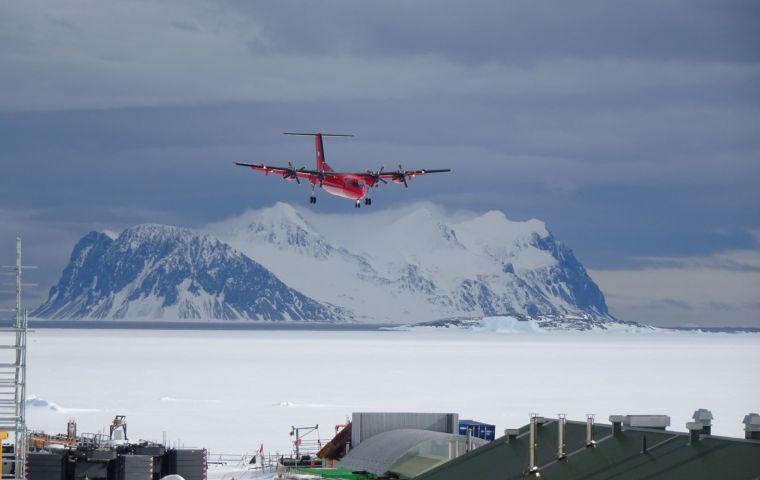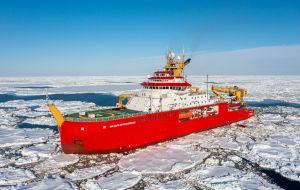MercoPress. South Atlantic News Agency
British Antarctic Survey field season has finished; RRS Sir Attenborough returns to UK after seven months
 Dash-7 aircraft landing at Rothera Station. She made 28 round trips between Falklands and Rothera, transporting over 300 passengers. (Pic B.Thursfield)
Dash-7 aircraft landing at Rothera Station. She made 28 round trips between Falklands and Rothera, transporting over 300 passengers. (Pic B.Thursfield)  The ship leaves behind 35 ‘winterers’ who will remain at Rothera, King Edward Point and Bird Island research stations ‘overwintering’ (Pic BAS/J.Anderson)
The ship leaves behind 35 ‘winterers’ who will remain at Rothera, King Edward Point and Bird Island research stations ‘overwintering’ (Pic BAS/J.Anderson) RRS Sir David Attenborough departed Rothera Research Station for the final time earlier in May and is now making its way back to the UK, marking the end of the BAS Antarctic summer field season.
The ship completed its maiden voyage successfully and returns to the UK after a seven-month mission to deliver scientific and operational staff to Antarctica, and to resupply BAS’ five research stations for another year.
The ship leaves behind 35 ‘winterers’ who will remain at Rothera, King Edward Point and Bird Island research stations ‘overwintering’ and supporting long-term scientific research projects for the next five-six months.
Dave Wattam, Head of Polar Operations at British Antarctic Survey says: “This has been a long season for BAS, and unusually bad weather and Covid-19 continued to present challenges to operational and field teams. Despite this, we are pleased to have deployed over 500 people South and kept our ship and stations Covid free!”
The Dash 7 aircraft made 28 round trips between the Falkland Islands and Rothera, transporting over 300 passengers. The Twin Otters made a total of 412 flights, transporting people between Rothera, Halley and deep-field science and logistics sites.
Fifty six science projects, carried out in collaboration with more than ten different organizations, were supported from the five research stations this year. This was a mixture of standalone and multi-season field and marine projects, as well as ongoing data collection for longer time series, such as the Rothera Time Series which collects information about the ocean over many seasons and years. Projects included attaching tracking devices to seabirds, investigating growth rates of key benthic species and measuring levels of nitrous acid gas above the snow in coastal Antarctica.
Some of these projects were deep-field projects, and involved traversing huge distances over the ice. In total, almost 12,000km – roughly the distance from the UK to Argentina – was traversed by five Pisten Bullys – tracked snow vehicles used to transport vehicles, sledges and living accommodation to remote field sites.
The season wasn’t without its challenges. Unprecedented sea ice conditions thwarted RRS Sir David Attenborough from reaching a cargo drop off point for International Thwaites Glacier Collaboration.
This also marks the end of a successful season of construction for the Antarctic Infrastructure Modernization Program (AIMP). Construction was completed on the outer skeleton and the ground floor slab of the new Discovery Building, and the build of the Site Wide Services (such as electric, potable water, drainage, fuel and communication). The successful construction season paves the way for finishing off the external envelope installation of doors, windows and the communications tower next season, a significant milestone for the Discovery Building project and for BAS. Once external works are complete next season will focus on finishing the internal fit out and the start of commissioning.
The Discovery building offers many advantages in the way in which BAS operates at Rothera. The two-storey building provides 4500m2 of floor space that provides flexibility to BAS teams managing multiple operations at varying times of the year to support Science and Field Guides deployments across the Antarctic. The building uses latest design methodologies to reuse and reduce carbon to deliver the life support systems for Rothera Research Station.
David Brand, Rothera Modernization Senior Project Manager says: “It is a great achievement for BAS to have successfully delivered another construction season with our construction partner BAM on the external build of the Discovery Building and SWS. We now have just two seasons remaining of the build before we commence the final finishes, commissioning of the Building’s services, and BAS can move in.
“We have certainly turned the corner and we have a very exciting season ahead where we will see the full external fabric of the building be installed and we will for the first time see the full size of the building sitting amongst the legacy buildings at Rothera.” (BAS)




Top Comments
Disclaimer & comment rulesCommenting for this story is now closed.
If you have a Facebook account, become a fan and comment on our Facebook Page!